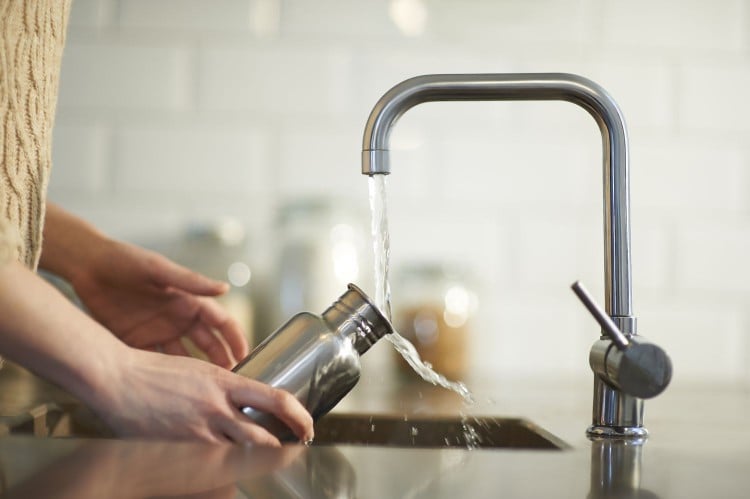- Experts agree that it’s important to wash your reusable water bottle on a regular basis, but whether that’s daily or every few days depends on how you use it.
- For the most sanitary vessel to drink out of, it’s wise to wash your water bottle (or at least the mouthpiece) every day—or after every use if you use it for something other than water.
- Though a dirty water bottle is unlikely to make you ill, the risk is never zero, and using an unclean water bottle may cause gastrointestinal or respiratory symptoms.
Reusable water bottles like the coveted Stanley tumbler have become the must-have wellness item, and it’s easy to see their appeal—they’re a greener alternative to single-use bottles, offer continuous hydration, and can even accessorize your outfit.
But the vessels also come with a downside: They can harbor germs and gunky buildup.
Grimy water bottles are on full display on social media. In one recent TikTok video that garnered nearly 100,000 likes, a creator shared that she had just discovered she could take apart the lid on her Stanley bottle and then displayed the small parts, which were covered with blackish, mold-like spots.
“Any time a bottle isn’t clean and there’s moisture in that bottle, that is always going to support the growth of microorganisms like bacteria and mold,” Bucknavage told Health. “Bacteria are in your mouth and the environment, so they are going to make their way into your bottle.”
The prospect of a germ-infested water bottle isn’t just icky but could be a potential health hazard, Donald Schaffner, PhD, a professor of food science at Rutgers University, told Health. While there’s a pretty slim chance of a dirty bottle exposing you to something pathogenic, said Schaffner, “it’s not zero probability.”
This raises the question: What’s the best way to keep your water bottle gunk-free?
Here’s how often you should clean your bottle, the ideal way to do it, and whether going too long without cleaning can affect your body.

Dougal Waters/Getty Images
How Often Should You Clean Your Water Bottle?
Experts agree that it’s important to wash your bottle on a regular basis, but whether that’s daily or every few days can depend on a few factors.
If you use your bottle daily, Schaffner said, washing it weekly or once every couple of days would be a “reasonable” timeframe. But how it’s stored and what it’s made of may change that calculation. “If the bottle is in a backpack or purse and the part you put your mouth on is bumping into things, it will probably get dirtier faster than if it just sits next to you all day,” he said.
Furthermore, plastic may be more conducive to microorganisms because it’s rougher than stainless steel or glass, Schaffner said, and therefore could have more crevices for bacteria to lodge into. “Plastic can also absorb odors,” he added.
Bucknavage, however, recommends cleaning your bottle at the end of each day it’s used. “It’s like any type of food surface, whether it’s a plate or a glass or a water bottle,” he said. “To really maintain good sanitary standards, a good daily cleaning is the way to go.”
You may want to up that to after each use if you fill your bottle with something other than water, he said. Coffee or sugary drinks allow bacteria to proliferate more easily and, to a lesser extent, mold as well.
If you’re low on time or energy, both Schaffner and Bucknavage advise prioritizing washing the bottle’s mouthpiece over other parts. And if your cleaning routine simply becomes too difficult to keep up with, Schaffner offers an alternative standard: “If your bottle looks dirty—clean it.”
The Best Method for Washing Your Water Bottle
The dishwasher is probably the most effective way to clean a bottle, provided it’s dishwasher safe, Schaffner said. Also make sure the opening is wide enough for the dishwasher to fully clean the interior.
Hand-washing can also work well—but it has to be more than just a rinse. Use soap and scrubbing tools like bottle brushes, Bucknavage said. And to reach inside the tiny grooves and crevices where “bacteria like to hang out,” such as the bottle’s cap, Schaffner said he likes to use a toothbrush. Straw cleaner brushes, which cost just a few dollars for a pack, are another useful tool.
Occasionally sanitizing your bottle using scalding water, white vinegar, and water, or a diluted chlorine solution can also be helpful, Bucknavage said, though it’s not necessary if you’re only using it for water and washing it daily.
What is necessary? “Making sure you let [your bottle] air dry to get all the water out,” he said.
Signs You May Need to Wash Your Water Bottle More Often
According to Schaffner, a funky smell or residue buildup means it’s time for a bottle scrub. Dark spots can indicate the presence of mold, and gray-blackish (or possibly light pink) slimy scum suggests biofilm, a substance secreted by microorganisms.
If you routinely clean your vessel but notice spottiness that won’t disappear, Schaffner said it’s probably “mold pigments that have discolored the surface” and are unlikely to hurt you. But “if it grosses you out, go ahead and get another bottle.”
What Can Happen If You Don’t Regularly Wash Your Water Bottle?
Skipping water bottle cleanings might make your bottle look dirty or water taste off, but you probably won’t get sick from it. “Water bottles aren’t huge on the list of things I worry about people getting sick from,” Schaffner said.
That’s because most bacteria coming from your mouth or outside environment are harmless. And even if your bottle does come in contact with a disease-causing organism—if it, for example, is sitting next to a cutting board and “chicken juice is spraying everywhere”—whether it would cause illness would still depend on many factors, Schaffner said, including the number of cells it picks up and the strength of your immune system.
It’s also unlikely that most people would ingest or inhale enough toxic mold chemicals (mycotoxins) to the point of causing illness. At that point, there’s a good chance the bottle would be so moldy and smelly that you wouldn’t want to drink from it in the first place.
Of course, the risk of illness is never zero, and a bacterial infection may cause vomiting, diarrhea, and other gastrointestinal symptoms.
If you do have a reaction to mold inhalation, it might manifest as irritation of the “eyes, nose, sinuses, and lungs,” said Melanie Carver, chief mission officer with the Asthma and Allergy Foundation of America, in an email. People with mold allergies or asthma can experience symptoms associated with those conditions, such as coughing, congestion, and shortness of breath.
It’s clear that to help prevent illness—and to cut back on the gross factor—washing is key. So if you’re considering buying a reusable water bottle, Bucknavage has some advice: “Make sure the bottle you’re choosing is something you’re going to be willing to clean.”








